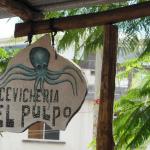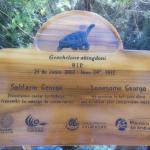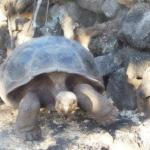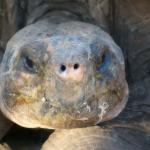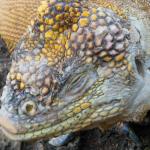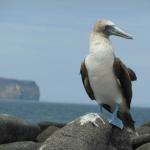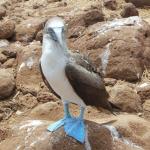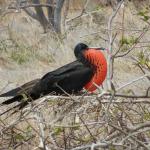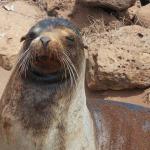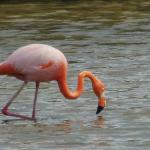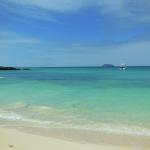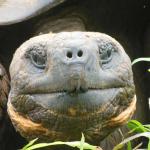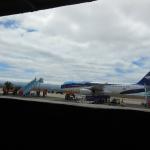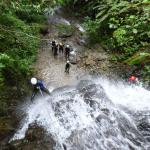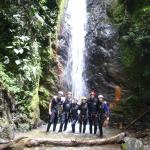© 2011 Sabrina Swenson. All Rights Reserved.
Galapagos
November, 2012
A famous archipelago known to early explorers as the enchanted isles. The Galapagos islands are a remote, seemingly barren chain of volcanic islands located on the equator approximately 620 miles off of mainland Ecuador. It's home to some astounding wildlife, many species of which can be found nowhere else on earth.
My trip to the Galapagos had me landing in the capital of Ecuador; Quito. After a quick night at an airport hotel I was off the next morning for my flight to Baltra which is a tiny island just North of the island of Santa Cruz. On arrival I hopped a bus to the ferry and 10 minutes later was on Santa Cruz. I then caught a local bus for about an hour for the journey to the town of Puerto Ayora. This town has the largest population in the Galapagos of approximately 18,000. Most people are surprised that there's more to the Galapagos than just plants and animals. I hopped off the bus in the middle of town and found a small hotel with a view of the ocean. After checking in and leaving my gear, I walked around town stopping at a few of the travel companies that offered boat tours of the islands. After picking one for the following day I walked over to the Darwin Research Station. More than 200 scientists and volunteers are involved with research and conservation efforts for the islands. It is, of course, named after Charles Darwin, the English naturalist. Giant Galapagos tortoise and land iguanas can be seen at the center. At one point I watched two tortoise eating their lunch and I crouched down to get some up close pictures. To my surprise both came towards me. I sat for a long time while these two posed for me just inches away. I got very up close shots and was amazed to hear them breathing, sounding just like a human. After several hours at the station, I went for a stroll around town and found a little place that served ceviche, one of my favorite dishes. Ceviche is made from fresh raw fish marinated in citrus juice along with chili peppers and often onions, salt and coriander. The restaurant was nothing more than a vacant spot with some plastic chairs and tables thrown down with small flowers on the tables for a bit of color. Nevertheless, the meal was perfect.
The following day I woke early and was picked up and transported to the boat I would be on. A group of Italians probably in their late 60's were on this boat as well. They laughed, smiled and enjoyed themselves like a group of school kids. We set off for the first island and upon landing climbed up the craggy rock face. As I waited for the Italians to climb up I enjoyed looking around at the rough terrain of the island. When I turned to look behind me, I was startled to see a huge frigate bird soaring in the thermal right above my head. It was startling as frigate birds have up to 7 1/2 feet wing spans! They have the largest wing span to body weight ratio of any bird and are perfectly silent in flight. These giant birds also have forked tails giving them an almost evil appearance. Once the Italians arrived we set off on foot to cover the small island. There were no roads, trails and certainly not anyone living there, it was just one of the many uninhabited island of the Galapagos. The wildlife we came across didn't seem the least bit bothered by our presence. After the frigate bird welcome, the next animal we came upon was the star of the Galapagos, the blue-footed booby. This funny bird has brilliant light blue feet. Interestingly, when courting, the male will flaunt his blue feet and dance to impress the female. We also saw land iguanas which are a vibrant yellowish-orange color. While feeding on seaweed, iguanas ingest large amounts of salt water. They possess salt glands, located between their eyes and nostrils, which concentrate and remove salt. The salt is deposited in the nostril where it is subsequently ejected by a "sneezing" action. It was amusing to see them "sneezing" the salt out. They instead just looked like they had a really bad cold. As we walked along we saw more frigate birds nesting. The males have large red gullar sacs (or pouches) which they distend in mating season to attract females. The females, on the other hand, have white throats and breasts. On the way back to the boat we also saw sea lions basking in the sun. With tiny ears and a look on their face which resembled a smile they looked perfectly content and happy to be on the island. We then pushed off and had a delicious lunch on board the chef had cooked us. We stopped at another small island for a snorkel and saw pink flamingos and red crabs on the rocks nearby. Eventually we headed back to Puerto Ayora. I stayed a few more days on the Galapagos and hit a few more of the islands. Each had wonderful wildlife. The last day I drove to the highlands of Santa Cruz and saw more of the famous Galapagos turtles. These huge things have a life expectancy in the wild of over 100 years. They are up to 5'9" long and weigh up to 880 pounds. As herbivores, they forage 8-9 hours a day.
I eventually caught a flight back to the mainland and the Southern Ecuadorian city of Cuenca. This lovely colonial city is a gem. I first read about it in Kiplinger's Personal Finance magazine years ago as being a great place to retire and so wanted to check it out since I was in the area. It is dated back to the 16th century and it's historic center is a UNESCO world heritage site. With it's cobblestone streets, beautiful buildings and many churches it's a joy to walk around.
After a few days I caught an eight hour local bus to Banos; a tiny town surrounded by mountains in central Ecuador. I found a hotel with a great view from the roof and walked around town. I was happy to find an adventure company that offered exactly what I was looking for, the opportunity to go canyoning. Although this is the local term, I personally would call it "rappelling down waterfalls!" I first learned to rappel years ago in Mexico and had always wanted to try it down waterfalls. I picked a top company which had a practice stand right next to their office. I showed up the following morning along with several other people. We donned wetsuits and after a bit of practice headed off in a truck to the waterfalls. We climbed up a mountain side for a bit before coming upon our first of five waterfalls. Having rappelled before, I wondered why there was green plastic attached to the harness which covered our behinds. I was informed that was for the sixth waterfall which we were going to slid down! We approached the first fall and with water spray everywhere we slipped and slided getting into place regardless of the fact they gave us special shoes to help with rubber soles. I got into position and went down the slippery slope. The water was freezing cold in spite of the full length wetsuit. I carefully made my way down and did pretty well until almost to the bottom when I slipped, lost my footing and went crashing down hitting my hip on a big rock. A large bruise was my reminder of the first falls. The rest of the group of six made their way down eventually and from there we walked through the water and jungle to our next fall. Each fall was higher and more difficult than the one before. At the fifth and final falls I headed down and at one point was straddling the falls while the entire frigid water flow was hitting me square on forcing me to turn my head to be able to breath. I eventually made my way to the bottom and upon unhooking myself looked up and thought "If I had seen that falls before we started this trip... I would have never signed up!". The sixth falls we slid down and although it was much smaller than what we rappelled, it was still a bit scary as you had nothing to hang on to. We ended up plopping into a water hole at the end after a very hasty descent! It was a fun day and the six of us and our two guides headed back to the truck and we all piled into the truck bed for a smashed, wet ride back to Banos.
The following day I rented a dune buggy to bomb around the countryside. This less than safe "vehicle" was just a shell of a buggy with no speedometer or blinkers. With minimal controls, I tore off for a day of roughhousing around the countryside of Banos with the wind in my hair. Banos was a lovely little place and after exploring much of it I hopped another local bus for three hours to the capital of Quito.
Quito is located high in the Andes mountains and has very dramatic mist-covered peaks surrounding it. The old town of Quito is also a UNESCO world heritage site. It has narrow streets and restored colonial architecture. I spent one afternoon in the Basilica del Voto Nacional, a massive Gothic church and climbed to the top of the clock towers for a great view over the city. Another day I enjoyed an ice cream in the Plaza Grande of the old town simply taking in the locals going about their day. A few more leisurely days spent in the capital and I was on my flight back to Germany.
Ecuador is filled with kind and friendly people. It's easy to get around and is very reasonably priced. The Galapagos islands are a one-of-a-kind place filled with fantastic wildlife. It's one of the best places in the world for interacting with animals in the wild at such close range. It's not everyday you get to see a dancing bird with blue feet!




